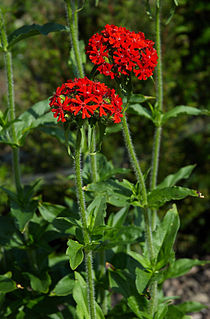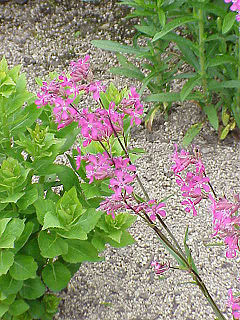
Caryophyllaceae, commonly called the pink family or carnation family, is a family of flowering plants. It is included in the dicotyledon order Caryophyllales in the APG III system, alongside 33 other families, including Amaranthaceae, Cactaceae, and Polygonaceae. It is a large family, with 81 genera and about 2,625 known species.

Silene chalcedonica, the Maltese-cross, flower of Bristol, Jerusalem cross, or nonesuch, is a species of flowering plant in the family Caryophyllaceae, native to central and eastern Russia, Kazakhstan, Mongolia and northwestern China.

Silene dioica, known as red campion and red catchfly, is a herbaceous flowering plant in the family Caryophyllaceae, native throughout central, western and northern Europe, and locally in southern Europe. It has been introduced in Iceland, Canada, the US, and Argentina.

Minuartia is a genus of flowering plants commonly known as sandworts in the family Caryophyllaceae.

The Caha Mountains are a range of low sandstone mountains situated on the Beara peninsula in south-west County Cork, in Ireland. The highest peak is Hungry Hill, 685 m (2,247 ft) tall. Other notable peaks include Knocknagree, Sugarloaf Mountain, Eskatarriff, Knocknaveacal, Derryclancy, Nareera, Killane Mountain and Baurearagh Mountain.

Honckenya peploides, the sea sandwort (UK) or seaside sandplant (Canada), is the only species in the genus Honckenya of the flowering plant family Caryophyllaceae. Other common names include sea chickweed, sea pimpernal, sea-beach sandwort, and sea purslane. The scientific name is often spelled "Honkenya", and is named after the German botanist Gerhard August Honckeny. This plant has a circumboreal distribution.

Arenaria montana, the mountain sandwort, is a species of flowering plant in the family Caryophyllaceae, native to mountainous regions of southwestern Europe, from the Pyrenees to Portugal. The Latin specific epithet montana refers to mountains or coming from mountains.

Minuartia groenlandica, the Greenland stitchwort or mountain stitchwort, Appalachian stitchwort, mountain sandwort, smooth mountain sandwort, and smooth sandwort is a rare perennial which grows low to the ground in clumps linked together at the bottom. It has three to five pairs of leaves in a linear opposite pattern along the length of the slender stem. The main stem breaks into one to thirty cymes which each flower separately. The flowers are white and arise five to ten centimeters above the thick foliage. The white flower petals are six to ten millimeters long. The petals are, in turn, surrounded by five green sepals.

Pterostylis recurva commonly known as the jug orchid, recurved shell orchid, antelope orchid or bull orchid, is a plant in the orchid family Orchidaceae and is endemic to the south-west of Western Australia. It is a relatively common orchid which has up to four jug-shaped or funnel-shaped white flowers with green and brown lines and markings. Non-flowering plants have a rosette of leaves on a short stalk.
Minuartia californica, commonly known as California sandwort, is a species of flowering plant in the family Caryophyllaceae.
Minuartia pusilla is a species of flowering plant in the family Caryophyllaceae known by the common names annual sandwort and dwarf stitchwort.
Minuartia rosei is an uncommon species of flowering plant in the family Caryophyllaceae known by the common names peanut sandwort and peanut stitchwort.

Minuartia rubella is a species of flowering plant in the family Caryophyllaceae known by several common names, including beautiful sandwort, mountain sandwort, Arctic sandwort, and boreal stitchwort. It has a circumboreal distribution, occurring throughout the northernmost Northern Hemisphere from the Arctic Circle on the Arctic tundra into the alpine climates of mountainous areas in temperate Eurasia and North America. It grows in rocky, moist, often barren habitat, including gravelly, sparsely vegetated slopes with little organic matter. It is a calciphile, growing in calcareous substrates such as soils rich in decomposed limestone.

Minuartia stolonifera is a rare species of flowering plant in the pink family known by the common names Scott Mountain sandwort and stolon sandwort.
Minuartia stricta is a species of flowering plant in the family Caryophyllaceae known by the common names bog stitchwort, Teesdale sandwort and rock sandwort. It has a circumboreal distribution, occurring throughout much of the northernmost Northern Hemisphere from the lower Arctic into the alpine climates of mountainous areas in temperate Eurasia and North America. It grows in several types of habitat, including meadows, marshes, heath, beaches and bars, and arctic and alpine tundra.

Minuartia cumberlandensis is a rare species of flowering plant in the pink family known by the common names Cumberland stitchwort and Cumberland sandwort. It is endemic to the Cumberland Plateau near the Big South Fork of the Cumberland River in Tennessee and Kentucky. This rare plant is found only in cool sandstone rock shelters, on the moist sandy cave floors behind the drip line. There are 27 occurrences in Tennessee and one in Kentucky. The plant is a federally listed endangered species.

Viscaria vulgaris, the sticky catchfly or clammy campion, is a flowering plant in the family Caryophyllaceae.

Minuartia patula, common names pitcher's stitchwort or lime-barren sandwort, is an annual plant in the family Caryophyllaceae. It is native to sections of the eastern and central United States, primarily the lower Mississippi Valley, the southern Great Plains, and the Tennessee Valley, with additional scattered populations in Georgia, Virginia, Pennsylvania, and the southern Great Lakes region.
Minuartia handelii or Handei-Maceti's sandwort, is a perennial plant of the family Caryophyllaceae. It is a stenoendemic from the mountain Čvrsnica, Bosnia and Herzegovina.
Minuartia bosniaca, or Bosnian sandwort, in Bosnian bosanska mišjakinjica, is endemic plant at East Dinaric mountains. Itbelongs to family of Caryophyllaceae (carnations).

















